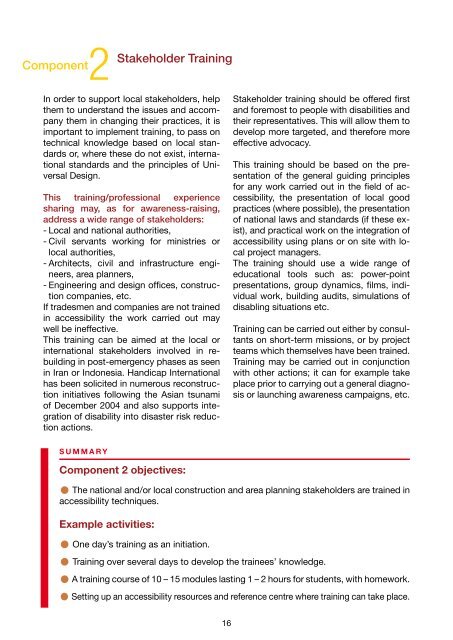Accessibility - Handicap International
Accessibility - Handicap International
Accessibility - Handicap International
Create successful ePaper yourself
Turn your PDF publications into a flip-book with our unique Google optimized e-Paper software.
Component2<br />
Stakeholder Training<br />
In order to support local stakeholders, help<br />
them to understand the issues and accompany<br />
them in changing their practices, it is<br />
important to implement training, to pass on<br />
technical knowledge based on local standards<br />
or, where these do not exist, international<br />
standards and the principles of Universal<br />
Design.<br />
This training/professional experience<br />
sharing may, as for awareness-raising,<br />
address a wide range of stakeholders:<br />
- Local and national authorities,<br />
- Civil servants working for ministries or<br />
local authorities,<br />
- Architects, civil and infrastructure engineers,<br />
area planners,<br />
- Engineering and design offices, construction<br />
companies, etc.<br />
If tradesmen and companies are not trained<br />
in accessibility the work carried out may<br />
well be ineffective.<br />
This training can be aimed at the local or<br />
international stakeholders involved in rebuilding<br />
in post-emergency phases as seen<br />
in Iran or Indonesia. <strong>Handicap</strong> <strong>International</strong><br />
has been solicited in numerous reconstruction<br />
initiatives following the Asian tsunami<br />
of December 2004 and also supports integration<br />
of disability into disaster risk reduction<br />
actions.<br />
Stakeholder training should be offered first<br />
and foremost to people with disabilities and<br />
their representatives. This will allow them to<br />
develop more targeted, and therefore more<br />
effective advocacy.<br />
This training should be based on the presentation<br />
of the general guiding principles<br />
for any work carried out in the field of accessibility,<br />
the presentation of local good<br />
practices (where possible), the presentation<br />
of national laws and standards (if these exist),<br />
and practical work on the integration of<br />
accessibility using plans or on site with local<br />
project managers.<br />
The training should use a wide range of<br />
educational tools such as: power-point<br />
presentations, group dynamics, films, individual<br />
work, building audits, simulations of<br />
disabling situations etc.<br />
Training can be carried out either by consultants<br />
on short-term missions, or by project<br />
teams which themselves have been trained.<br />
Training may be carried out in conjunction<br />
with other actions; it can for example take<br />
place prior to carrying out a general diagnosis<br />
or launching awareness campaigns, etc.<br />
S U M M A R Y<br />
Component 2 objectives:<br />
•<br />
The national and/or local construction and area planning stakeholders are trained in<br />
accessibility techniques.<br />
Example activities:<br />
•<br />
•<br />
•<br />
•<br />
One day’s training as an initiation.<br />
Training over several days to develop the trainees’ knowledge.<br />
A training course of 10 – 15 modules lasting 1 – 2 hours for students, with homework.<br />
Setting up an accessibility resources and reference centre where training can take place.<br />
16

















